How to Migrate Goal Setting to the Remote Environment
Let's explore some of the current challenges that have an impact on goal setting.
Importance of goal setting
Every successful business needs to have a clear goal setting process in place. Goals and objectives unify and motivate individuals, teams and organizations. They provide employees with a clear metric to measure their success, and they encourage alignment throughout the organization.
Enter COVID-19. Last year's goals are no longer relevant, and with the majority of teams working from home, company leaders need to migrate their goal setting process to the remote environment, or risk low levels of employee engagement and productivity. In this webcast, we explore some of the current challenges that have an impact on goal setting, as well as provide a range of solutions to remote goal setting to help your organization thrive.
Embedded content: https://www.youtube.com/embed/HmsKjZEgWDg
Current challenges when setting goals remotely
Fragmented Communication
The transition from the office environment to the home environment has had a massive impact on the way we communicate. There has been a shift from continuous face to face communication, to fragmented virtual communication, where interactions are less frequent, scheduled and take place through video meetings, voice calls, instant message and email. All organizations are feeling the strain caused by lack of face to face communication, and we need to restore this as much as possible in the remote working environment.
Lack of clarity
When working in the office, it is easy to have regular informal check-ins with managers and peers about objectives, which keeps us on track to achieving our goals and dealing with any changes quickly. Working at home can lead to a lack of clarity with regards to daily, weekly and quarterly goals. Therefore there is a need for more established methodologies that are thoroughly followed in the remote environment to ensure that goals and objectives are clear throughout the organization.
Reskilling
The transition to remote work has led to the need for different type of skill set, with a heavier focus on soft skills, such as time management and virtual communication. As the way we work is changing, so are the required skills that we need to succeed. In addition, a lot of companies are incorporating new technology to assist their employees in the transition to remote work, yet many employees are not ready to use these new technologies as they have not had the necessary training.
Realignment
Last year's strategic direction has been turned upside down by COVID-19, and might now be irrelevant. Organizations across the globe need to realign their strategic goals and set new objectives in order to survive and thrive beyond the pandemic. However, employees will undoubtably be disappointed if their objectives have changed, and frustrated if they do not understand why. This could lead to low levels of productivity and engagement.
Low visibility
Working from home means that we are more isolated whilst working towards our goals, and it is easy to feel separated from the wider organizational objectives. There is also a danger of feeling disconnected from the team goals and therefore working in silos. Finally, without the physical office space, there can be a lack of transparency across the organization as information sharing and communication is impeded.
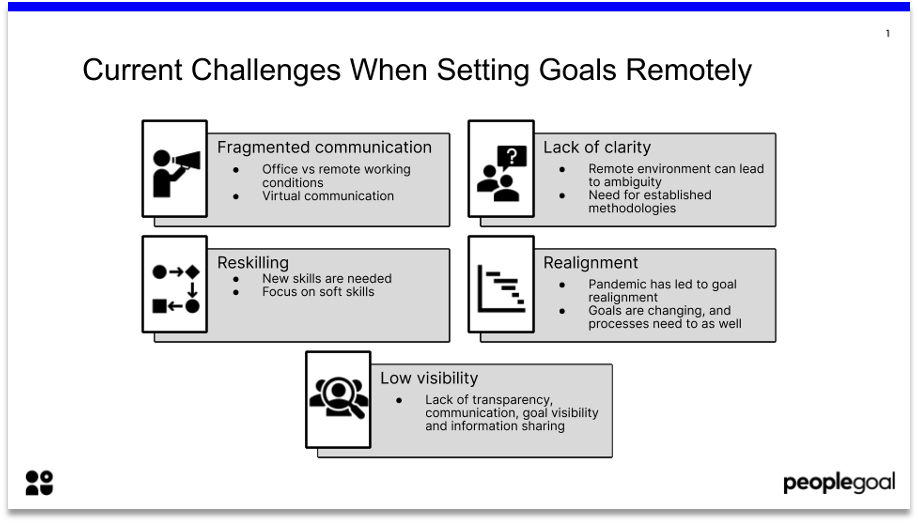
How to succeed in a remote environment
1. Create clear virtual channels of communication and use them
Everyone should make an effort to connect with their peers, teams and managers especially while working remotely. However, it is also the organization's responsability to create clear channels of virtual communication and use them, for example Slack or Microsoft Teams. Other tools which encourage collaboration such as Notion or Trello are also a great way to set tasks and create alignment across virtual teams.
It is also vital to have daily check-ins as well as weekly team meetings to check-in on goals. It is the responsibility of both the manager and the employee to stay on track of progress, both in terms of top down and bottom up feedback. There should be frequent discussion of goals to stay aligned and on track, as well as allowing goals to adapt to the changing company needs. Finally, there should be regular progress reports where employees are given feedback on their progress, and help with any issues that arise.
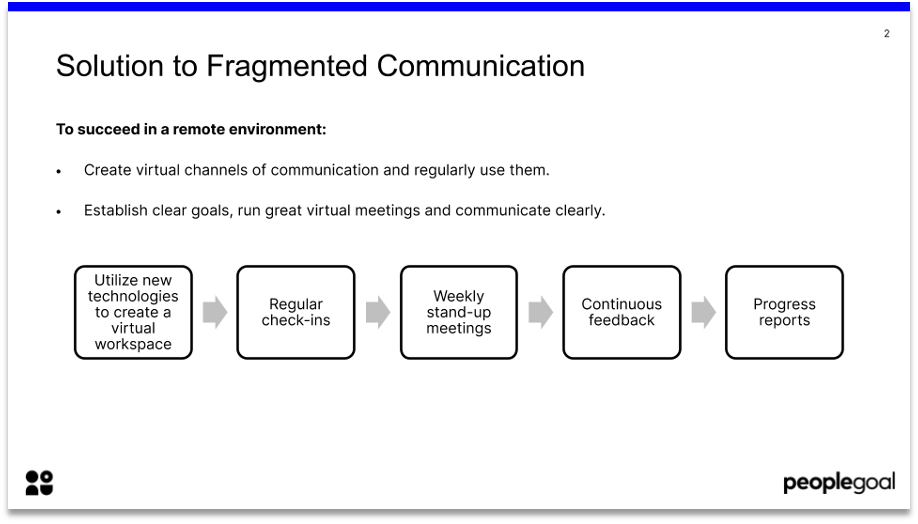
2. Establish clear goal setting methodologies
It is essential to migrate the office environment to the remote environment. Make sure that goals and objectives are cristal clear. It is important to use established goal setting methodologies, for example SMART goals or OKRs which will provide employees with clarity on exactly what they are meant to achieve. This does not only apply to employees, company leaders also need to set SMART goals and OKRs for the organization as a whole in order to lead with clear direction.
Setting goals is only half of the job. It is also necessary to use the right technology to track goal and objective process to ensure that everyone is hitting their targets at the right time. Try to automate objective setting by creating a process where both teams, employees and management can communicate their goals and objective to the wider organziation and provide feedback. Finally, set clear metrics to measure the results.
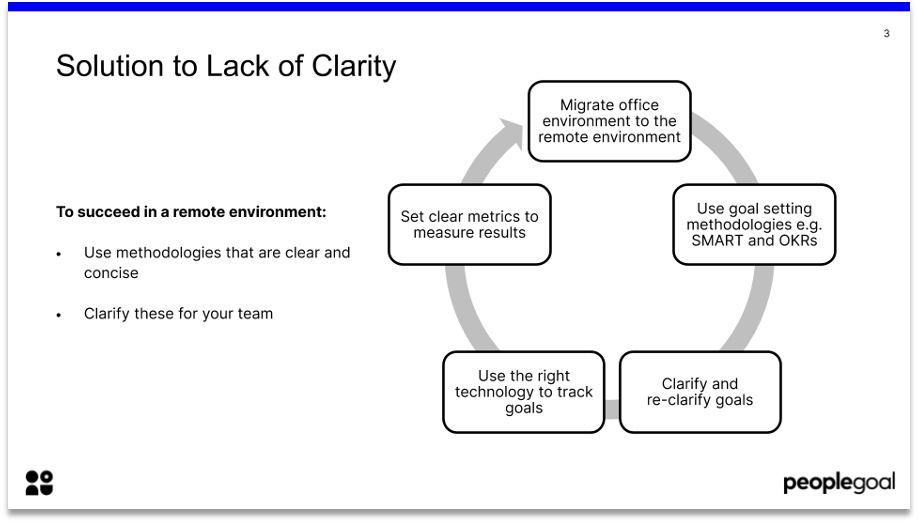
3. Shift focus from hard skills to soft skills
Reskilling is a hot topic at the moment, and it is important to understand why. There has been a shift in the skill set needed to succeed from the office environment to remote working. It is essential that we understand the differences in soft skills required to perform, and learn these new skills and their desired behaviour. For example, remote workers need to strengthen their communication, time management, self-efficacy and technology.
Leaders need to share new metrics of success, since they are no longer able to judge employee effectiveness based on hours spent in the office. We have covered the numerical aspect of work with SMART goals and OKRs, and now we need to ensure that we also remain aligned with soft skills when it comes to goal setting. The pandemic has changed the way we work, and now we need to evaluate the way we work under remote circumstances.
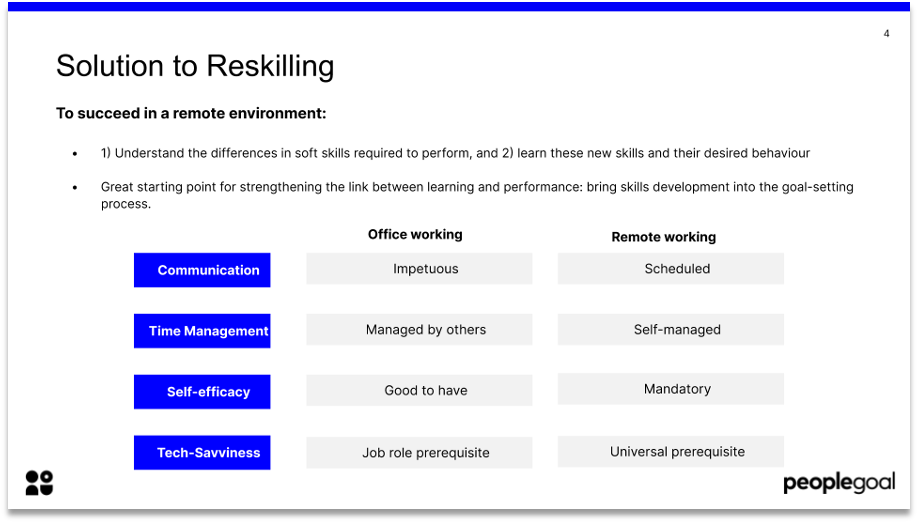
4. Take care when realigning objectives
It is essential that leaders take care when realigning objectives. This year, everyone set their goals for 2020 without factoring in a global pandemic and since everyone has had to go back and realign their strategic goals and team objectives. When realigining goals, there will undoubtably be some resistance from employees, therefore it is essential that leaders take care when doing this.
In order to realign with success, managers need to open up the process. Be transparent with employees as to why realignment is needed, and ask teams to test and validate assumptions, and give their feedback on the process. This is the best way to ensure that new objectives are clear, and are accepted by employees.
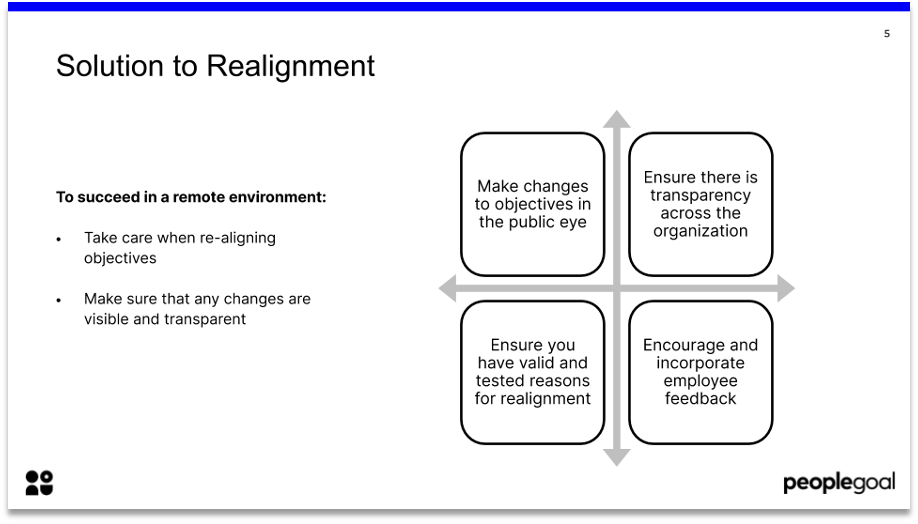
5. Ensure there is full transparency and visibility regarding goals and objectives
Nowadays we don't have the visibility with teams and managers that we would normally have under office circumstances. We are not interacting with senior leaders or key stakeholders as often as we used to, and this is having a direct impact on morale, motivation and how we perceive our contribution to the overall organisation.
If employees can see the company vision and what other teams are doing, it will give them the confidence that their work is helping the organization achieve its goals. In practice, this means that company objectives should be visible and cascaded down through the organization, so that individuals can align their goals with company objectives.
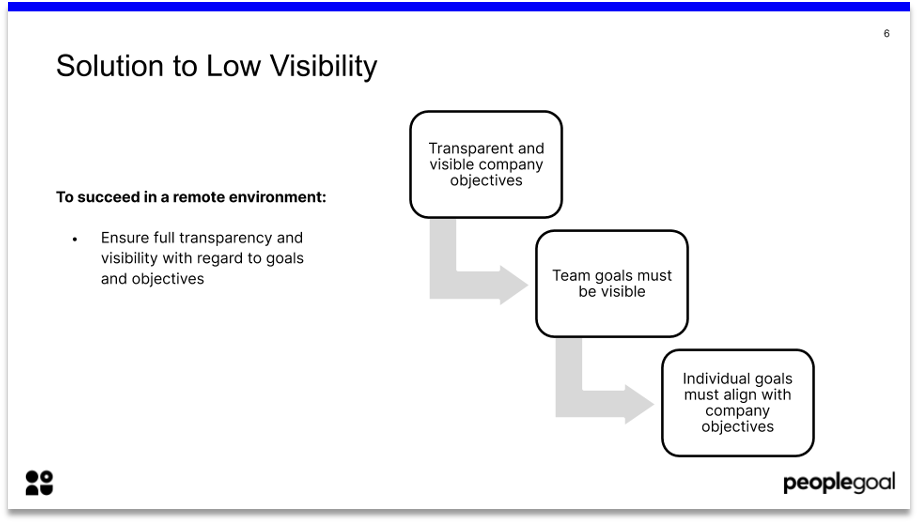
Final reflections
- The 'new normal' requires us to work differently
- Create clear channels of virtual communication
- Follow a methodology-based goal setting approach (SMART goals, OKRs)
- Focus on measuring the skills that matter (especially soft skills)
- Realign organizational goals with care
- Goals need to be visible across the organization
Want to learn more?
Enjoyed learning about migrating goal setting to the remote environment? Check out the full webcast here.
Want to streamline your goal setting process? Book a demo with PeopleGoal here.
